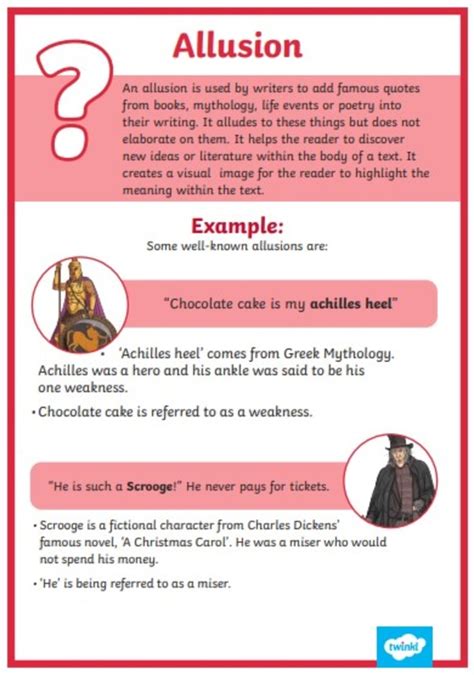In the tapestry of literature, allusions serve as vibrant threads that weave a intricate web of meaning, enhancing the narrative’s depth and revealing hidden layers within characters. By carefully employing allusions, authors can evoke iconic figures, archetypal events, or literary motifs to illuminate the significance, perspective, and appearance of individuals within a work.

The Importance of Allusions
Allusions transcend the boundaries of a specific text, connecting it to a broader cultural and historical context. They can:
- Elevate a character’s status by associating them with renowned figures or events, such as Hercules or the Trojan War.
- Establish a character’s role or purpose by linking them to archetypal figures, such as the hero or the villain.
- Create a sense of mystery or intrigue by hinting at a character’s hidden connections or motivations.
The Perspective of Allusions
Allusions can shape the reader’s perspective on a character by providing a frame of reference and evoking preconceived notions. For instance:
- Comparing a character to Achilles suggests strength and courage.
- Drawing parallels to Hamlet highlights indecision and contemplation.
- Referencing Icarus cautions against hubris and overambition.
The Appearance of Allusions
In addition to revealing a character’s importance and perspective, allusions can also influence their physical appearance. For example:
- A character described as having “golden locks” may be likened to Apollo or Rapunzel.
- A villain with “emerald eyes” might evoke the malevolence of the Green Goblin. li>A hero adorned in “shining armor” resembles Saint George or Lancelot.
Unveiling Character Depth with Allusions
Authors throughout history have masterfully employed allusions to craft unforgettable characters. Here are a few notable examples:
- In Shakespeare’s Hamlet, the titular character is often associated with the Greek hero Oedipus, evoking themes of fate and tragedy.
- F. Scott Fitzgerald’s Jay Gatsby is likened to the mythical King Midas, highlighting his pursuit of wealth and the ultimate price of his desires.
- J.R.R. Tolkien’s Frodo Baggins bears similarities to Odysseus from Homer’s Odyssey, embarking on an epic journey marked by challenges and self-discovery.
Table 1: Allusions to Enhance Character Importance
| Allusion | Character | Significance |
|---|---|---|
| Hercules | Odysseus | Strength, courage, and perseverance |
| Trojan War | Achilles | Honor, loyalty, and the cost of heroism |
| Saint George | Lancelot | Chivalry, valor, and the battle against evil |
Table 2: Allusions to Shape Narrative Perspective
| Allusion | Character | Perspective |
|---|---|---|
| Hamlet | Macbeth | Indecision, guilt, and the consequences of ambition |
| Icarus | Icarus | Hubris, overconfidence, and the dangers of pushing limits |
| Oedipus | Oedipus | Fate, destiny, and the search for truth |
Table 3: Allusions to Influence Character Appearance
| Allusion | Character | Physical Attribute |
|---|---|---|
| Apollo | Daphne | Golden locks |
| Green Goblin | Severus Snape | Emerald eyes |
| Shining Armor | Don Quixote | Chivalrous attire |
Table 4: Notable Authors’ Use of Allusions
| Author | Work | Allusions |
|---|---|---|
| Shakespeare | Hamlet | Oedipus, Hercules, Icarus |
| F. Scott Fitzgerald | The Great Gatsby | King Midas, Achilles |
| J.R.R. Tolkien | The Lord of the Rings | Odysseus, Hamlet, Saint George |
Conclusion
Allusions are a powerful literary device that can reveal a character’s importance, perspective, and appearance, enriching the narrative with depth and complexity. By evoking iconic figures, archetypal events, and literary motifs, authors can create characters that resonate with readers and linger in their minds long after the last page is turned.
